The $60 CPU Question: AMD Athlon 200GE or Intel Pentium Gold G5400? A Review
by Ian Cutress on January 14, 2019 8:00 AM ESTGaming: Grand Theft Auto V
The highly anticipated iteration of the Grand Theft Auto franchise hit the shelves on April 14th 2015, with both AMD and NVIDIA in tow to help optimize the title. GTA doesn’t provide graphical presets, but opens up the options to users and extends the boundaries by pushing even the hardest systems to the limit using Rockstar’s Advanced Game Engine under DirectX 11. Whether the user is flying high in the mountains with long draw distances or dealing with assorted trash in the city, when cranked up to maximum it creates stunning visuals but hard work for both the CPU and the GPU.
For our test we have scripted a version of the in-game benchmark. The in-game benchmark consists of five scenarios: four short panning shots with varying lighting and weather effects, and a fifth action sequence that lasts around 90 seconds. We use only the final part of the benchmark, which combines a flight scene in a jet followed by an inner city drive-by through several intersections followed by ramming a tanker that explodes, causing other cars to explode as well. This is a mix of distance rendering followed by a detailed near-rendering action sequence, and the title thankfully spits out frame time data.
| AnandTech CPU Gaming 2019 Game List | ||||||||
| Game | Genre | Release Date | API | IGP | Low | Med | High | |
| Grand Theft Auto V | Open World | Apr 2015 |
DX11 | 720p Low |
1080p High |
1440p Very High |
4K Ultra |
|
There are no presets for the graphics options on GTA, allowing the user to adjust options such as population density and distance scaling on sliders, but others such as texture/shadow/shader/water quality from Low to Very High. Other options include MSAA, soft shadows, post effects, shadow resolution and extended draw distance options. There is a handy option at the top which shows how much video memory the options are expected to consume, with obvious repercussions if a user requests more video memory than is present on the card (although there’s no obvious indication if you have a low end GPU with lots of GPU memory, like an R7 240 4GB).
All of our benchmark results can also be found in our benchmark engine, Bench.
| GTA V | IGP | Low | Medium | High |
| Average FPS | 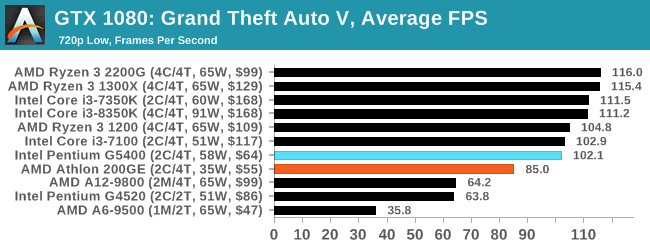 |
 |
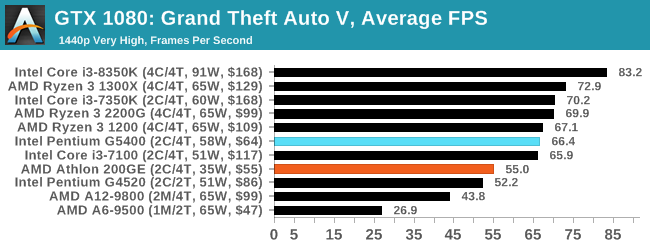 |
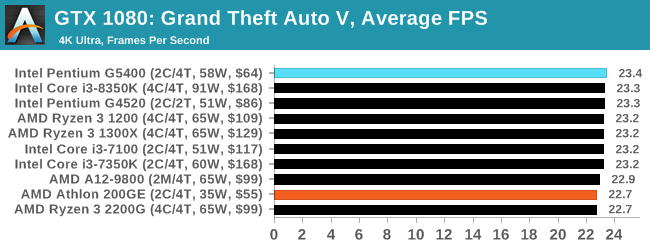 |
| 95th Percentile | 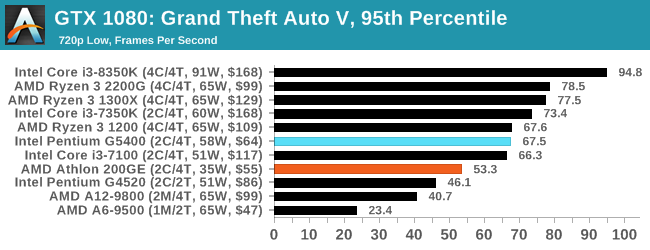 |
 |
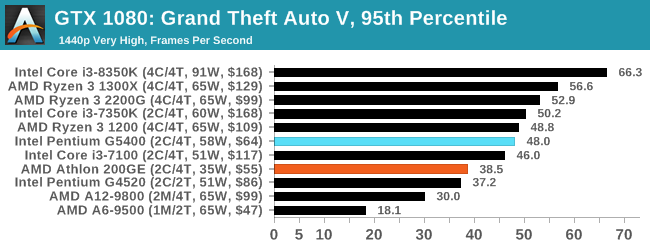 |
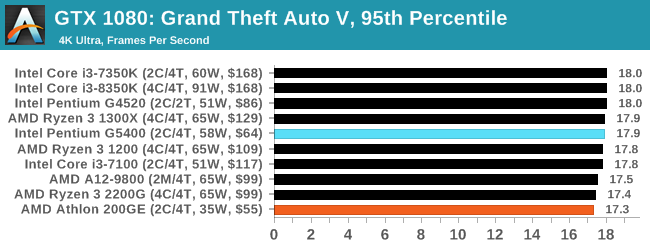 |
This popular test gives a clear win for the G5400, except at 4K where the parts are very similar.












95 Comments
View All Comments
mczak - Monday, January 14, 2019 - link
Yes, I'd expect at least the Athlon to be quite close to its TDP with simultaneous CPU+IGP load.The Pentium probably not really (although the Pentium G5500/G5600 could get close, as these have the GT2 (UHD 630) rather than the GT1 (UHD 610) graphics, which also should be much more competitive with the Athlon).
biiiipy - Monday, January 14, 2019 - link
In my country the cheapest I can find is 200GE for 50€ andG5400 for 90€... yeah...ET - Monday, January 14, 2019 - link
Very nice to see a low end comparison, and a quite comprehensive one at that.What I don't understand is why quite a few benchmarks (especially on the IGP tests) are missing some of the CPUs.
Rudde - Monday, January 14, 2019 - link
The test setup table doesn't include the G5400.shabby - Monday, January 14, 2019 - link
The g5400 is $183 on amazon...T1beriu - Monday, January 14, 2019 - link
You should have measured the power consumption for 100% CPU load + 100% GPU load, lile POV + Furmark?Flunk - Monday, January 14, 2019 - link
These are close enough that I would buy whichever I could get cheaper (with a compatible board of course).Targon - Monday, January 14, 2019 - link
Of course, if you are looking to start low but then upgrade later, socket AM4 will allow upgrades from the lowest end to top end.edzieba - Tuesday, January 15, 2019 - link
So could the Pentium, right to the 9900k.eastcoast_pete - Monday, January 14, 2019 - link
@Ian: thanks, and I agree with your conclusion, but only if the ~$60 mark is a hard upper limit. Take-home for me: if you believe that you're going to be working and gaming on the iGPU of the chip even for a few months, try as hard as you can to get the extra $40 and buy the Ryzen 2200 G instead, which retails for $99 or so. That is still the value king here, and by a big margin. Unlike either the Pentium or the Athlon, the 4 cores and the (much beefier) iGPU of the 2200G can provide the 25-30 frames/second in many of the games tested here, has generally superior performance on non-gaming applications as well, and, once the dedicated graphics card arrives, it still gives a better showing than either Athlon or Pentium. Plus, as Gavin here and others on their sites have shown, there is significant headroom left for overclocking if that extra 10% or so is a must-have. So, long in short: For a budget system, and if at all possible, get the Ryzen 2200G. It is well worth the 40 bucks more.